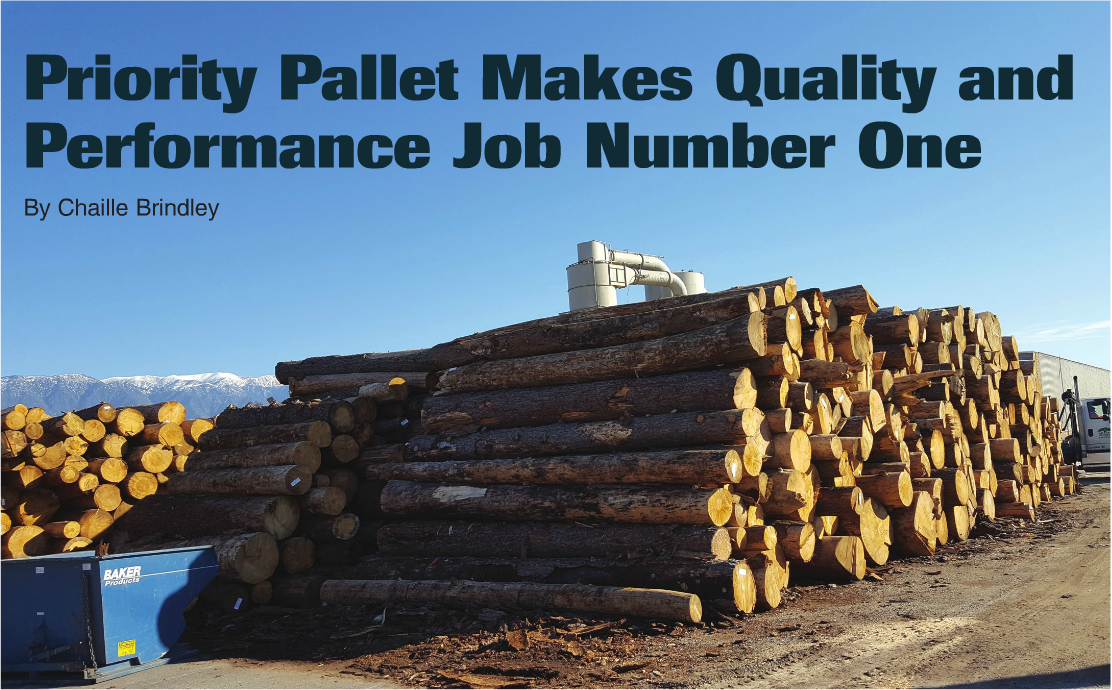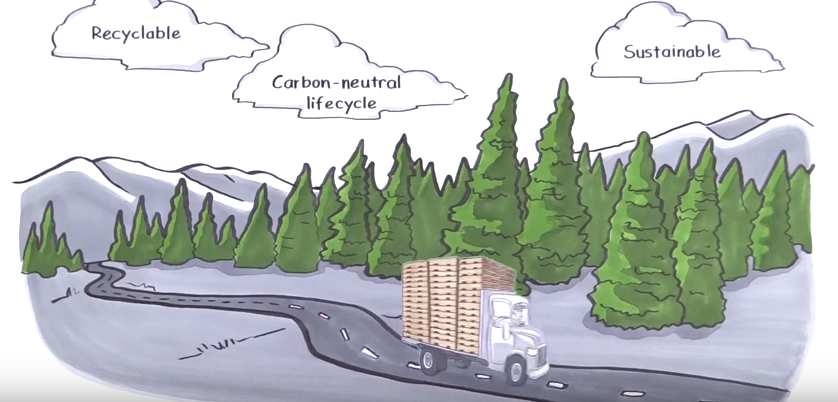Priority Pallet
Major California pallet company sets high standard for quality, environmental certification and fire safety. Unique for the West Coast, it cuts own logs on a Baker saw line.
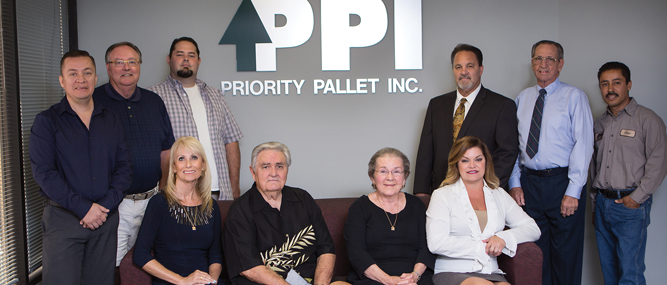
True Green Lumber: Priority is certified by SFI for procuring logs and lumber sourced from sustainable sources. One of the few pallet companies carrying this certification, it gives Priority a competitive advantage fro Fortune 500 customers.
Ray Gutierrez Sr.’s commitment to quality is evident as soon as you see his company’s property from the highway. Stacks of neatly organized pallets with everything in its place stands as a stark contrast to what you might find at many other facilities. This commitment to proper execution has allowed the company to attract major corporate clients, recognition as one of the few companies in the country with Sustainable Forestry Initiative (SFI) certification for its lumber, and a strong safety record that others hope to emulate.
Ray Sr. owns both Commercial Lumber & Pallet Co. (CL) and Priority Pallet (Priority), making his operations one of the largest pallet companies in the country. The Priority facility in Beaumont, California sits on 15 acres and looks more like a distribution center from the outside than a typical pallet plant. The facility services high volume customers. CLP and Priority are known more as pallet manufacturers, but they do a small amount of recycling for select customers. The Priority facility is one of the few places in California where a pallet company processes raw logs and turns them into pallet lumber. It installed a Baker saw line several years ago to process bug kill and other salvage logs.

This Baker line was designed to handle a wide variety of materials including low quality salvage logs. Today, it processes higher value logs than in the past. It can also process lumber or cants.
Western pallet companies typically buy precut and random length softwoods from suppliers in Northern California, the Pacific Northwest, and western Canada. Priority secured a $1.3 million grant from the U.S. Forest Service partnering with the Riverside County Economic Development Agency to turn harvested infested timber and turn it into pallet stock. The goal was to have somewhere to take all the diseased timber in nearby forests. Prior to the Priority project, the federal government had been paying to have infested material removed and ground into wood fiber. In addition to material from the national forest, Priority Pallet has access to private land timber.
Ray Gutierrez Jr., vice president of Priority, explained that Clyde Reed of Baker Products had encouraged them to put in a system that could be flexible, and capable of processing logs or cants. And it has paid off well giving the company the flexibility it needs to respond to the market.
Ray Sr. laughed, “We had to learn how to be in the sawmill business.” When his company first started the sawmill there was a lot more downfall than they wanted. Part of it was due to the condition of the logs. But over time, the line has become quite efficient. Ray Sr. commented, “Baker makes good heavy duty equipment that has worked well regardless of what we throw at it. And there is minimal downtime due to maintenance.”
Another major differentiating factor for Priority is its focus on order and cleanliness. Kathleen Dietrich, vice president of Priority, said that Riverside County fire officials were so impressed with what Priority has done from a fire prevention and preparation stand point that they are considering using this facility as a model for others to follow.
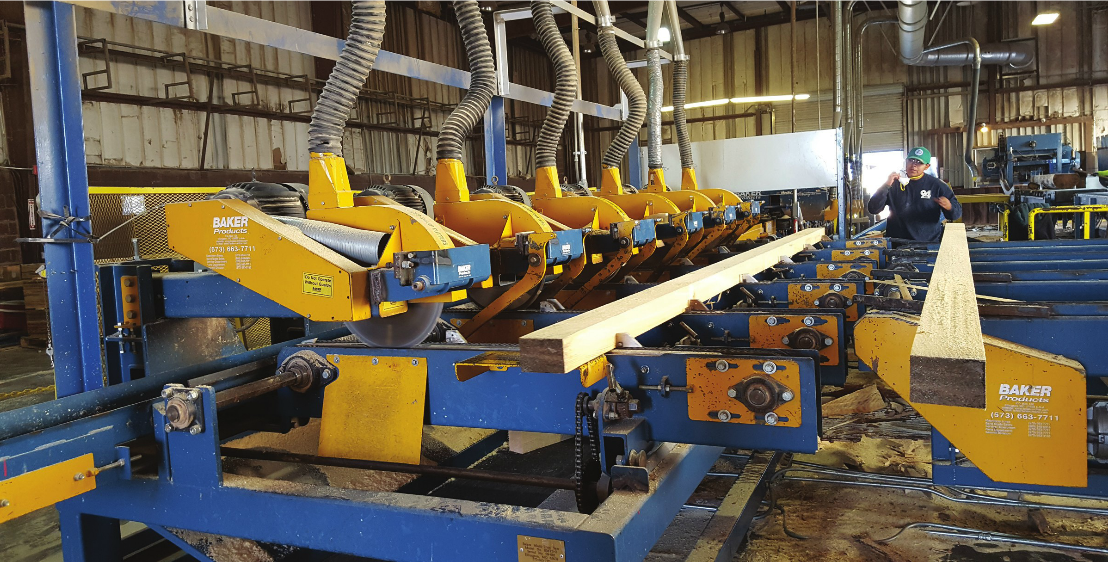
Most pallet companies in the West buy primarily precut and RL material. This sawmill makes Priority unique in its ability to process lumber from many different sources.
Priority’s sister company was just the victim of an arson attack. And several strategies deployed at both sites was helpful in mitigating possible damage. Dietrich explained that surveillance footage showed a person walking down the side of the property with two cans of something and this was used to start the fire at the CLP facility. She declared, “This is not an accident, somebody is deliberately setting these fires.” (See the article on page 46 about pallet arson in California).

Priority received a federal grant to process salvage logs from federal land. This has positioned Priority to be able to respond to changing lumber markets. Today it processes both lumber and logs from private land.
Dietrich outlines several steps that have helped improve the fire safety of their facilities. She pointed to the placement of fire hydrants throughout the facility making it easier for fire fighters to get water to the scene. Also, they stagger piles of pallet stacks with piles of lumber. Since lumber is harder to get going than pallets, this provides a fire break of sorts. Also, pallet stacks are kept away from the fence and are aligned with large aisleways to provide space that can slow the spread of a fire. The height of pallet stacks are limited to 20 feet high. The company also has lights placed in strategic areas to help eliminate dark areas where people can hide. And Priority employs guards to patrol the facility both during and after hours. Guards at the CLP facility were responsible for noticing the fire as it first began and calling for help almost immediately. This quick response time certainly kept the CLP fire from being a lot worse.
The company has an active fire management plan in place to check fire extinguishers annually. Also, the entire sawdust collection system is monitored and sprinkled. The moment the system detects any spark, an alert is sent. All of these precautions add costs to the bottom line.
Reducing clutter and good housekeeping practices go a long way to reducing fire loads. Ray Sr. added, “Anybody can do good housekeeping. It is a matter of your priorities.”
Lumber Processing
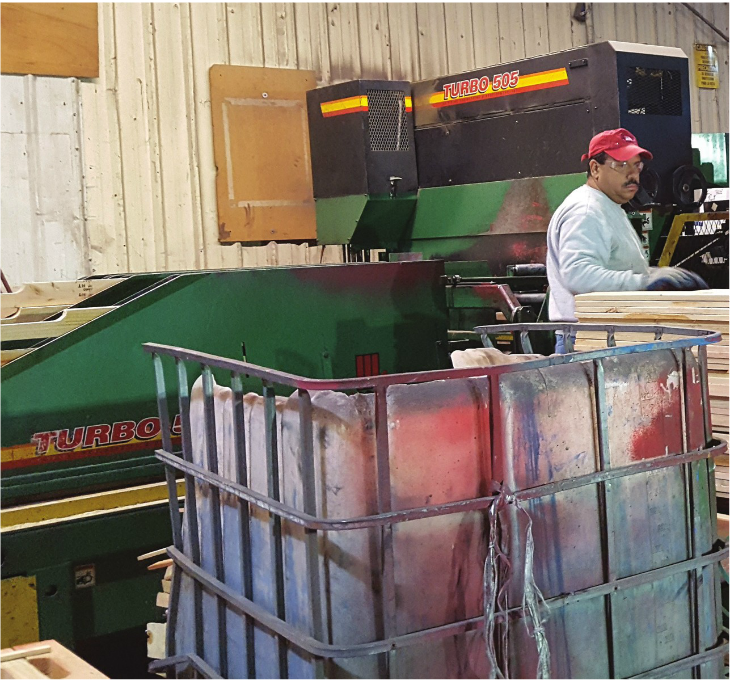
Quick changeover between designs and efficient production are two key reasons why Priority chose this machine
Priority’s sawmill is versatile to handle logs, cants or precut boards. The process starts with a Baker Super Streak Sawmill, operated by one person.
The Baker Blue Streak is Baker’s most common mill. In the Baker Super Streak, the sawyer controls every aspect of the mill from a control console using joy sticks and a few foot pedals while seated in a comfortable climate controlled booth.
This unique mill system has been designed for Priority Pallet to cut a log into flitches, not boards. The Baker mill cuts a log down into 3-1/2″ thick flitches, starting with a narrow flitch from the first cut and working toward wider flitches as you go further and deeper into each log and then ending with a narrow flitch on the final cut. These flitch sections travel on a roll case that feeds a circular gang edger with five 14″ diameter circular saw blades which has spacers set at 5-1/2″. Thus, the circular gang edger creates 3-1/2″x5-1/2″ cants.
The edging strips will travel via a belted pan waste conveyor to a vibrating conveyor feeding the West Salem Machinery 3232BH hog. Hogged edging strips and wood fiber residue is used for soil amendment products, sold to nurseries as bagged product for fertilizer, flower planting, etc.

Stacks of pallets are separated by lumber to provide a fire break to slow down the spread of fire. This approach works well since lumber is harder to ignite than pallet stacks.
Cants from the gang edger are cut into shorter lengths on a six-head Baker circular saw multi-head trim saw. Next a Baker six-head band resaw with 20 hp motors resaws each cant into the desired cut stock dimensions. A Baker M6 Deduster removes the remaining sawdust from the cut stock, which transfers onto a Baker off-stacking conveyor. Baker stacking racks and two-yard dumpsters are simple but important parts of the system to handle finished lumber and lumber scraps. Baker also designed the complete waste removal system for the entire system. It will handle end trim blocks and shim cuts or any materials determined to be waste.
Today, 80% of what Priority processes is raw logs compared to 20% random width material. The company buys mainly sugar pine and ponderosa pine. It does not cut any grade at the mill. Thus, some customers get some very nice, almost furniture grade material.
Dietrich commented, “We are not usually the cheapest, but we strive to offer the best service.”

This machine can produce both block and stringer pallets. Today it hums along producing one set design for a major Priority customer
Both CLP and Priority are certified by SFI, which makes it unique in the marketplace. SFI certification guarantees that lumber and logs are procured from companies that are following laws and harvesting timber in a sustainable manner.
Dietrich said, “SFI certification sets us apart. Our sales team has used this certification because major Fortune 500 companies want to work with companies who are green.”
Getting certified is no easy task. It requires a ton of paperwork to show where you source your material. Certification is good for five years, and annual audits are conducted to ensure compliance.
Dietrich explained some of the administrative effort involved. The companies maintain vendor certification numbers on file and tracks every lumber purchase. They both conduct internal audits. An accurate paper trail is required from an initial order of lumber through to receiving and payment.
The SFI process includes an assessment of any raw materials from outside of North America to avoid such issues as illegal logging operations. Dietrich volunteered that the record keeping required is not that easy initially but maintaining it is much easier to do.
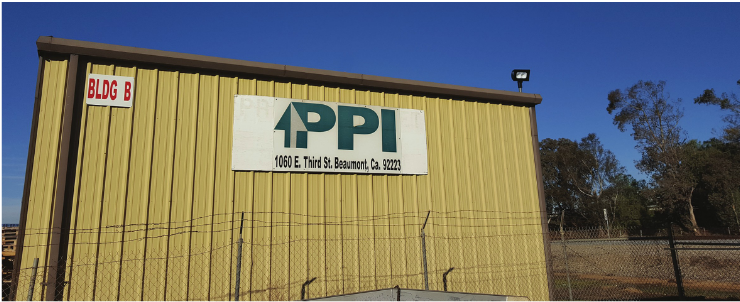
Priority uses lights, security guards and other safety procedures to help mitigate security and arson concerns.
The Right Building Serves as a Strong Foundation
The Beaumont facility was bought in 1999 from Square D, a manufacturer of electrical equipment. Ray Sr. recalled that it was the first time he had ever been interviewed by a seller to see if it would sell the property to him. He said that Square D wouldn’t sell the property to just anyone. The company had a strong commitment to the environment and wanted to make sure that the new owner shared these values.
Ray Sr. said, “We were the only company that Square D prequalified to bid on the property, and the company’s leadership was very helpful in our transitioning to this property.”
The buildings and layout had to be optimized for pallet production and a sawmill. Ray Sr. said, “In 1999, we didn’t know what we were going to do with so much land. Today, we have had to lease more to keep up with demand.”
Ray Sr. laughing recalled, “We never intended on having a sawmill or doing a lot of different things here that happened.” But he added that they always found a way to use every piece of land.
The CHEP service center work is conducted by hand at manual inspection and repair tables. Odd-sized and large pallets are produced by hand using pneumatic tools. Priority also uses automated nailing lines for higher volume orders. It has a Viking Turbo 505 and a GBN Excalibur nailing line. Priority bought the GBN for making block pallets for CHEP. Not it is primarily used to make one set pallet for a very large customer.
Ray Jr. said that they also really like the Viking Turbo 505 too. Its biggest advantage is a fast changeover between pallet designs. Ray Jr. added, “Both the Viking and GBN are reliable machines that have done well for us.”
Priority also produces heat treated pallets and is just about to install a Sii dry kiln that will doubles its capacity. The goal is to treat 2,400 pallets in three hours or less.
Good People Make the Difference
Ray Sr. who worked his way up the ladder to buy the company appreciates the dedication of his workforce. “My employees have everything that I have from health care coverage including dental to retirement and vacation time,” stated Ray Sr. Although the Priority facility is not a union shop, the workers there have all the same benefits as those at the CLP plant where it is unionized.
Ray Sr. said, “We have had 25 or so people retire from our combined companies through the years.” He believes in hiring good people and rewarding them for their efforts.
One of the most important things that Ray Sr. said he realized early in his management was that he couldn’t do everything. And he needed good people who were released to make smart decisions.
Pointing at Dietrich, he said she came to the company right out of high school. She is a partner at Priority and a key leader and manager at CLC. And she has also been an industry leader serving as the president of the Western Pallet Association twice. Dietrich laughingly said, “I was supposed to be a high school guidance counselor. I guess on some days, I kind of am. I fell in love with the industry at 19.”
“The only big difference between us and other pallet companies is our people. When you treat them right, people listen and pay attention,” declared Ray Sr.
